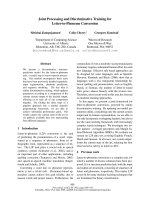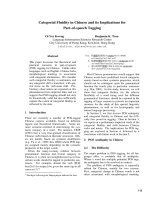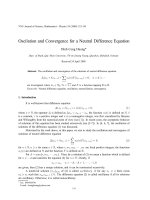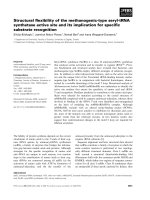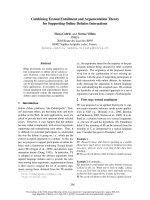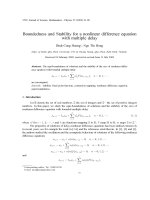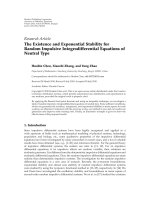ASYMPTOTIC ESTIMATES AND EXPONENTIAL STABILITY FOR HIGHER-ORDER MONOTONE DIFFERENCE EQUATIONS ´ ppt
Bạn đang xem bản rút gọn của tài liệu. Xem và tải ngay bản đầy đủ của tài liệu tại đây (587.41 KB, 15 trang )
ASYMPTOTIC ESTIMATES AND EXPONENTIAL STABILITY
FOR HIGHER-ORDER MONOTONE DIFFERENCE EQUATIONS
EDUARDO LIZ AND MIH
´
ALY PITUK
Received 21 May 2004
Asymptotic estimates are established for hig her-order scalar difference equations and in-
equalities the right-hand sides of which generate a monotone system with respect to the
discrete exponential ordering. It is shown that in some cases the exponential estimates can
be replaced with a more precise limit relation. As corollaries, a generalization of discrete
Halanay-type inequalities and explicit sufficient conditions for the global exponential sta-
bility of the zero solution are given.
1. Introduction
Consider the higher-order scalar difference equation
x
n+1
= f
x
n
,x
n−1
, ,x
n−k
, n ∈ N ={0,1,2, }, (1.1)
where k is a positive integer and f : R
k+1
→ R.With(1.1), we can associate the discrete
dynamical system (T
n
)
n≥0
on R
k+1
,whereT : R
k+1
→ R
k+1
is defined by
T(x) =
f (x),x
0
,x
1
, ,x
k−1
, x =
x
0
,x
1
, ,x
k
∈ R
k+1
. (1.2)
As usual, T
n
denotes the nth iterate of T for n ≥ 1andT
0
= I, the identity on R
k+1
.It
follows by easy induction on n that if (x
n
)
n≥−k
is a solution of (1.1), then
x
n
,x
n−1
, ,x
n−k
=
T
n
x
0
,x
−1
, ,x
−k
, n ≥ 0. (1.3)
Therefore, the dynamical system (T
n
)
n≥0
contains all information about the behavior of
the solutions of (1.1).
In a recent paper [7], motivated by earlier results for delay di fferential equations due
to Smith and Thieme [13] (see also [12, Chapter 6]), Krause and the second author have
introduced the discrete exponential ordering on
R
k+1
, the partial ordering induced by the
convex closed cone
C
µ
=
x =
x
0
,x
1
, ,x
k
∈ R
k+1
| x
k
≥ 0, x
i
≥ µx
i+1
, i = 0,1, ,k − 1
, (1.4)
Copyright © 2005 Hindawi Publishing Corporation
Advances in Difference Equations 2005:1 (2005) 41–55
DOI: 10.1155/ADE.2005.41
42 Monotone difference equations
where µ ≥ 0 is a parameter. In [7], it has been shown that T is monotone (order preserv-
ing) under appropriate conditions on f . As a consequence of monotonicity, necessary
and sufficient conditions have been given for the boundedness of all solutions and for the
local and global stability of an equilibrium of (1.1) (see [7, Section 4]).
In this paper, we give further consequences of the monotonicity of T for (1.1)andfor
the corresponding difference inequality
y
n+1
≤ f
y
n
, y
n−1
, , y
n−k
, n ≥ 0, (1.5)
under the additional assumption that the nonlinearity f is positively homogeneous (of
degree one) on the generating cone C
µ
, that is,
f (λx) = λf(x)forλ ≥ 0, x ∈ C
µ
. (1.6)
An example of (1.1)withproperty(1.6)isthemaxtypedifference equation
x
n+1
=
k
i=0
K
i
x
n−i
+ bmax
x
n
,x
n−1
, ,x
n−r
, (1.7)
where k and r are positive integers and the coefficients K
i
and b are constants. For other
examples of higher-order di fference equations with a positively homogeneous right-hand
side, see, for example, [6].
Using the monotonicity of T and a simple comparison theorem, we give upper ex-
ponential estimates for the solutions of (1.5) in terms of the largest positive root of the
characteristic equation
λ
k+1
= f
λ
k
,λ
k−1
, ,1
. (1.8)
As a corollary for the difference inequality
y
n+1
≤
k
i=0
K
i
y
n−i
+ bmax
y
n
, y
n−1
, , y
n−r
, (1.9)
we obtain a generalization of earlier results of Ferreiro and the first author [8] on discrete
Halanay-type inequalities (see Theorems 1.1 and 3.1). For other related results, see, for
example, [1, 9, 10].
Further, we will show that a mild strengthening of the monotonicity condition in [7]
implies that the map T is eventually strongly monotone. As a consequence, a nonlinear
version of the Perron-Frobenius theorem [3] applies and we obtain an asymptotic rep-
resentation of the solutions of (1.1)startingfromC
µ
(see Theorems 1.2 and 3.7). For a
similar result, using the standard ordering in R
k+1
(µ = 0), see [6].
Finally, we establish an asymptotic exponential estimate for the growth of the solutions
of the equation
x
n+1
=
k
i=0
K
i
x
n−i
+ g
n,x
n
,x
n−1
, ,x
n−r
, (1.10)
E. Liz and M. Pituk 43
under the assumption that its linear part
y
n+1
=
k
i=0
K
i
y
n−i
(1.11)
generates a monotone system and the growth of the nonlinearity g : N × R
r+1
→ R is
controlled by a positively homogeneous function which is nondecreasing in each of its
variables (see Theorems 1.3 and 3.10). As a corollary, we obtain explicit sufficient condi-
tions for the global exponential stability of the zero solution of (1.10) (see Theorems 1.4
and 3.11).
The following four theorems give a flavor of our more general results presented in
Section 3. Without loss of generality, we assume that in all Theorems 1.1, 1.2, 1.3,and1.4
below, k ≥ r. The first theorem offers an upper estimate for the solutions of i nequality
(1.9).
Theorem 1.1. Suppose that b>0 and the re exists µ>0 such that
µ +
k
i=1
K
−
i
µ
−i
≤ K
0
, (1.12)
where K
−
i
= max{0,−K
i
}.Then,foreverysolution(y
n
)
n≥−k
of (1.9)thereexistsapositive
constant M = M(y
0
, y
−1
, , y
−k
) such that
y
n
≤ Mλ
n
0
, n ≥−k, (1.13)
where λ
0
is the unique root of the equation
λ
k+1
=
k
i=0
K
i
λ
k−i
+ bmax
λ
k
,λ
k−1
, ,λ
k−r
(1.14)
in the interval (µ,∞).
The next result shows in case of (1.7) the exponential estimate ( 1.13)ofTheorem 1.1
is sharp.
Theorem 1.2. Suppose that b>0 and (1.12)holdswithastrictinequalityforsomeµ>0.
Then, for every solution (x
n
)
n≥−k
of (1.7)withinitialdata(x
0
,x
−1
, ,x
−k
) ∈ C
µ
\{0},there
exists a positive constant L = L(x
0
,x
−1
, ,x
−k
) such that
λ
−n
0
x
n
−→ L as n −→ ∞ , (1.15)
where λ
0
has the meaning from Theorem 1.1.
The following theorem provides an estimate for the growth of the solutions of (1.10).
Theorem 1.3. Suppose that there exist b>0 and µ>0 such that (1.12)and
g
n,x
0
,x
1
, ,x
r
≤ b max
x
0
,
x
1
, ,
x
r
, n ≥ 0, x ∈ R
r+1
(1.16)
44 Monotone difference equations
hold. Then, for every solution (x
n
)
n≥−k
of (1.10) there exists a positive constant M = M(x
0
,
x
−1
, ,x
−k
) such that
x
n
≤ Mλ
n
0
, n ≥−k, (1.17)
where λ
0
has the meaning from Theorem 1.1.
The existence and uniqueness of the solution λ
0
of (1.14)in(µ,∞)isapartofthe
conclusions of Theorems 1.1, 1.2,and1.3. This λ
0
is a root of either
λ
k+1
=
k
i=0
K
i
λ
k−i
+ bλ
k
(1.18)
or
λ
k+1
=
k
i=0
K
i
λ
k−i
+ bλ
k−r
, (1.19)
depending on whether λ
0
≥ 1orλ
0
< 1. It will be shown (see Corollary 2.7)thatλ
0
< 1if
and only if, in addition to the hypotheses of Theorem 1.1, µ<1and
k
i=0
K
i
+ b<1. (1.20)
As a consequence of Theorem 1.3, we have the following criterion for the global expo-
nential stability of the zero solution of (1.10).
Theorem 1.4. Suppose that there ex ist b>0 and µ
∈ (0,1) such that (1.12), (1.16), and
(1.20) hold. Then, the zero solution of (1.10) is globally exponentially stable.
For the proofs of Theorems 1.1, 1.2, 1.3,and1.4,seeRemarks3.4, 3.9 and, 3.12.
In the special case K
0
≥ 0, K
i
= 0fori = 1,2, ,k and 0 <b<1 − K
0
, the conclusion
of Theorem 1.1, a discrete analogue of Halanay’s inequality, was obtained by Ferreiro and
the first author (see [8, Theorem 1]). The same remark holds for Theorem 1.4 (see [8,
Theorem 2]).
Under the hypotheses of Theorem 1.4, the global asymptotic stability of the zero so-
lution of (1.10) was established by the second author using a different approach (see [11,
Corollary 2 and Remark 2]).
The paper is organized as follows. In Section 2, we discuss the monotonicity properties
of the map T defined by (1.2). The main results on the behavior of the solutions of the
above higher-order difference equations and inequalities are given in Section 3.
2. Monotonicity
Recall the definition of the discrete exponential ordering from [7]. For every µ
≥ 0, the
convex closed cone C
µ
defined by (1.4) has nonempty interior intC
µ
given by
intC
µ
=
x =
x
0
,x
1
, ,x
k
∈ R
k+1
| x
k
> 0, x
i
>µx
i+1
, i = 0,1, ,k − 1
. (2.1)
E. Liz and M. Pituk 45
As a cone in R
k+1
,eachC
µ
induces a partial order ≤
µ
on R
k+1
by x ≤
µ
y if and only if
y − x ∈ C
µ
.Wewritex<
µ
y if x ≤
µ
y and x = y. The strong ordering
µ
is defined by
x
µ
y if and only if y − x ∈ intC
µ
.Theordering≤
µ
is called the discrete exponential
ordering. Note that the restriction µ<1in[7] is not needed here.
The following result follows immediately from the definition of the ordering ≤
µ
(see
also [7, Proposition 1]). It gives a necessary and sufficient condition for the map T defined
by (1.2) to be monotone. Recall that T is said to be monotone (increasing, order preserving)
on R
k+1
with respect to ≤
µ
if
T(y) ≥
µ
T(x)wheneverx, y ∈ R
k+1
satisfy x ≤
µ
y. (2.2)
Theorem 2.1. Let µ ≥ 0. The map T defined by (1.2) is monotone with respect to ≤
µ
if and
only if
f (y) − f (x) ≥ µ
y
0
− x
0
whenever x, y ∈ R
k+1
satisfy x ≤
µ
y. (2.3)
A relatively e asily verifiable sufficient condition for (2.3)toholdisgivenbelow.
Proposition 2.2 [7, Proposition 2]. Let µ>0. Condition (2.3) holds if there exist constants
L
i
, i = 0,1, ,k such that
f (y) − f (x) ≥
k
i=0
L
i
y
i
− x
i
whenever x
i
≤ y
i
for i = 0,1, ,k (2.4)
and
µ +
k
i=1
L
−
i
µ
−i
≤ L
0
, (2.5)
where L
−
i
= max{0,−L
i
}.
Note that in both previous results the domain R
k+1
of T can be replaced with a subset
of R
k+1
.
If f is differentiable, then the constants L
i
in (2.4) may be viewed as the infima of the
partial derivatives ∂f/∂x
i
(x), where the infimum is taken over all x ∈ R
k+1
.
The next theorem shows that a mild strengthening of the monotonicity condition (2.3)
implies that T is eventually strongly monotone.
Theorem 2.3. Let µ>0 and suppose that
f (y)
− f (x) >µ
y
0
− x
0
whenever x, y ∈ R
k+1
satisfy x<
µ
y. (2.6)
Then, T
k
is strongly monotone with respect to ≤
µ
,thatis,
T
k
(y)
µ
T
k
(x) whenever x, y ∈ R
k+1
satisfy x<
µ
y. (2.7)
46 Monotone difference equations
Proof. Let x, y ∈ R
k+1
satisfy x<
µ
y. We must show that T
k
(y)
µ
T
k
(x). In view of the
definition of intC
µ
and the relation
T
k
(x) =
f
T
k−1
(x)), f
T
k−2
(x)
, , f
T(x)
, f (x),x
0
, x ∈ R
k+1
, (2.8)
the last inequality is equivalent to the system of inequalities
f (y) − f (x) >µ
y
0
− x
0
> 0 (2.9)
and
f
T
i+1
(y)
− f
T
i+1
(x)
>µ
f
T
i
(y)
− f
T
i
(x)
> 0 (2.10)
for i = 0,1, ,k − 2. Since x<
µ
y, it follows that y
0
− x
0
> 0. (Otherwise, the condition
y − x ∈ C
µ
would imply that y = x, a contradiction.) Consequently, (2.6) implies (2.9).
Since T is monotone, T(y) ≥
µ
T(x). Further, by virtue of (2.9) and the definition of T,
we have
T(y)
0
−
T(x)
0
= f (y) − f (x) > 0 (2.11)
and hence T(y) >
µ
T(x). Using (2.6)again,wefind
f
T(y)
− f
T(x)
>µ
f (y) − f (x)
> 0. (2.12)
Thus, (2.10)holdsfori
= 0. Suppose for induction that (2.10)holdsforsomei ≥ 0. By
monotonicity, T
i+2
(y) ≥
µ
T
i+2
(x). Moreover, in view of (2.10) and the definition of T,we
have
T
i+2
(y)
0
−
T
i+2
(x)
0
= f
T
i+1
(y)
− f
T
i+1
(x)
> 0. (2.13)
Consequently, T
i+2
(y) >
µ
T
i+2
(x) and therefore (2.6)and(2.10)implythat
f
T
i+2
(y)
− f
T
i+2
(x)
>µ
f
T
i+1
(y)
− f
T
i+1
(x)
> 0. (2.14)
Thus, (2.10)holdsforalli = 0,1,2, As noted before, (2.9)and(2.10)implythat
T
k
(y)
µ
T
k
(x).
The next result is similar to Proposition 2.2.Itgivesasufficient condition for assump-
tion (2.6)ofTheorem 2.3 to hold.
Proposition 2.4. Let µ>0. Then, (2.6)holdsif(2.4) holds and the inequality in (2.5)is
strict,
µ +
k
i=1
L
−
i
µ
−i
<L
0
. (2.15)
The proof of Proposition 2.4 is an obvious modification of the proof of [7, Proposition
2] and thus it is omitted.
E. Liz and M. Pituk 47
In the next theorem, we describe some further properties of T under the additional
assumption that f is continuous and positively homogeneous on C
µ
. In particular, it can
be used to ensure the existence of a strongly positive eigenvector of T.
Theorem 2.5. Suppose that there exists µ ≥ 0 such that f is continuous on C
µ
and (1.6)
and (2.3)holdonC
µ
. Then, the following hold.
(i) T is a continuous, positively homogeneous, and monotone selfmapping of C
µ
.
(ii) If, in addition, it is assumed that
f
µ
k
,µ
k−1
, ,1
>µ
k+1
, (2.16)
then the characteristic equation (1.8)hasauniquerootλ
0
in (µ,∞). This root λ
0
is an eigenvalue of T and u
λ
0
= (λ
k
0
,λ
k−1
0
, ,1) is a corresponding strongly positive
eigenvector, that is,
T
u
λ
0
= λ
0
u
λ
0
, u
λ
0
µ
0. (2.17)
(iii) If instead of (2.3) the stronger condition (2.6)isassumed,then(2.16)holds.
Proof. (i) The continuity and the positive homogeneity of T are evident. The monotonic-
ity of T is a consequence of Theorem 2.1. The fact that T maps C
µ
into itself follows from
the monotonicity of T and the equality T(0) = 0.
(ii) Define
h(λ) = λ
k+1
− f
λ
k
,λ
k−1
, ,1
, λ ≥ µ. (2.18)
Since (λ
k
,λ
k−1
, ,1) ≥
µ
(0,0, ,0) for λ ≥ µ and f is continuous on C
µ
, h is continuous
on [µ,∞). Further, by virtue of (2.16), h(µ) < 0and,inviewof(1.6), we have
h(λ) = λ
k
λ − f
1,λ
−1
, ,λ
−k
−→ ∞ as λ −→ ∞ . (2.19)
This implies the existence of λ
0
>µsuch that h(λ
0
) = 0. This λ
0
is a root of (1.8)and
conclusion (2.17) is an immediate consequence of the definitions of T and the strong
ordering
µ
. It remains to show that (1.8) has no other root in (µ,∞). Let λ>µbe a root
of (1.8). Define u
λ
= (λ
k
,λ
k−1
, ,1). It is easily seen that
T
u
λ
=
λu
λ
, u
λ
µ
0. (2.20)
Thus, u
λ
is a strongly positive eigenvector of the continuous, positively homogeneous
and monotone selfmapping T of C
µ
. According to a result of Kloeden and Rubinov [3 ,
Corollary 3.1], the corresponding eigenvalue λ coincides with the spectral radius of T and
hence it is uniquely determined.
(iii) Clearly, (µ
k
,µ
k−1
, ,1) >
µ
(0,0, ,0). By virtue of (2.6), this together with f (0,
0, ,0) = 0, implies (2.16).
Remark 2.6. The previous proof shows that in case (ii) of Theorem 2.5, λ
0
< 1ifandonly
if µ<1and f (1,1, ,1) < 1.
48 Monotone difference equations
We conclude this section with some corollaries of the previous results for (1.7), a spe-
cial case of (1.1)when
f
x
0
,x
1
, ,x
k
=
k
i=0
K
i
x
i
+ bmax
x
0
,x
1
, ,x
r
. (2.21)
As in Section 1, we assume that k ≥ r in (1.7).
Corollary 2.7. Suppose that b ≥ 0 and µ>0. Then, the following hold.
(i) Condition (2.3)holdsfor(1.7)if(1.12)holds.
(ii) Condition (2.6)holdsfor(1.7)if(1.12)holdswithastrictinequality.
(iii) Condition (2.16)holdsfor(1.7)if(1.12)andoneofthefollowinghold:
(a) b>0,or
(b) b = 0 and K
i
> 0 for some i ∈{1, 2, , k},or
(c) b = 0, K
i
≤ 0 for i = 1,2, ,k and the inequality in (1.12)isstrict.
In that case, (1.14)hasauniquerootλ
0
in (µ,∞).Furthermore,λ
0
< 1 if and only if µ<1
and (1.20) holds.
Proof. Clearly, for f defined by (2.21), condition (2.4) holds with L
i
= K
i
for i = 0,1, ,k.
Consequently, conclusions (i) and (ii) follow immediately from Propositions 2.2 and 2.4.
To prove (iii), observe that, in view of (1.12), we have
f
µ
k
,µ
k−1
, ,1
= µ
k
k
i=0
K
i
µ
−i
+ bmax
1,µ
−1
, ,µ
−r
≥ µ
k
K
0
−
k
i=1
K
−
i
µ
−i
≥ µ
k+1
.
(2.22)
If (a), (b), or (c) holds, then one of the above inequalities is st rict and thus (2.16)holds.
The last two conclusions of (iii) follow from Theorem 2.5(ii) and Remark 2.6.
3. Main results
In the theorems below, we assume that f is positively homogeneous and satisfies either
the monotonicity condition (2.3)or(2.6). Sufficient conditions for (2.3)and(2.6)tohold
were given in Section 2 (see Propositions 2.2 and 2.4). The first theorem gives an upper
estimate for the solutions of inequality (1.5).
Theorem 3.1. Suppose that there exists µ
≥ 0 such that (1.6)and(2.3)hold.Ifthecharac-
teristic equation (1.8)hasarootλ
0
in (µ,∞), then for every solution (y
n
)
n≥−k
of (1.5)there
exists a positive constant M = M(y
0
, y
−1
, , y
−k
) such that
y
n
≤ Mλ
n
0
, n ≥−k. (3.1)
The existence of a root λ
0
of (1.8)in(µ,∞) can be guaranteed by Theorem 2.5(ii). We
have the following corollary of Theorems 2.5 and 3.1.
E. Liz and M. Pituk 49
Corollary 3.2. Suppose that there ex ists µ ≥ 0 such that f is continuous on C
µ
and condi-
tions (1.6), (2.3), and (2.16)hold.Then,(1.8)hasauniquerootλ
0
in (µ, ∞) and (3.1)holds
for every solution (y
n
)
n≥−k
of (1.5) with a positive constant M depending on the initial data
(y
0
, y
−1
, , y
−k
).
Remark 3.3. According to Theorem 2.5(iii), condition (2.16) automatically holds i f the
monotonicity assumption (2.3)inCorollary 3.2 is replaced with the strong monotonicity
condition (2.6).
Remark 3.4. Theorem 1.1 in Section 1 is a consequence of Corollaries 2.7 and 3.2.
Before we present the proof of Theorem 3.1, we establish a comparison theorem which
is interesting in its own right. Note that in this theorem we merely assume the monotonic-
ity condition (2.3).
Theorem 3.5. Suppose (2.3) holds for some µ ≥ 0.Let(x
n
)
n≥−k
and (y
n
)
n≥−k
be solutions
of (1.1)and(1.5), respectively, such that
y
0
, y
−1
, , y
−k
≤
µ
x
0
,x
−1
, ,x
−k
. (3.2)
Then, for all n ≥ 0,
y
n
, y
n−1
, , y
n−k
≤
µ
x
n
,x
n−1
, ,x
n−k
. (3.3)
In particular,
y
n
≤ x
n
, n ≥−k. (3.4)
Proof. We will prove (3.3) by induction on n. By assumption (3.2), (3.3)holdsforn = 0.
Suppose for induction that (3.3)holdsforsomen ≥ 0. In view of the definition of the
ordering ≤
µ
,(3.3) implies that
x
i
− y
i
≥ µ
x
i−1
− y
i−1
≥ 0 (3.5)
for i
= n − k +1,n − k +2, ,n. Using (1.1)and(1.5), we find for n ≥ 0,
x
n+1
− y
n+1
≥ f
x
n
, ,x
n−k
− f
y
n
, , y
n−k
≥ µ
x
n
− y
n
, (3.6)
the last inequality being a consequence of (2.3)and(3.3). Thus, (3.5)alsoholdsfori =
n + 1. Therefore,
y
n+1
, y
n
, , y
n+1−k
≤
µ
x
n+1
,x
n
, ,x
n+1−k
. (3.7)
Thus, (3.3) is confirmed for all n ≥ 0. Conclusion (3.4)followsfrom(3.3) and the defini-
tion of C
µ
.
We are in a position to give a proof of Theorem 3.1.
Proof of Theorem 3.1. Let (y
n
)
n≥−k
be a solution of (1.5). Consider the solution (x
n
)
n≥−k
of (1.1) with initial data
x
0
,x
−1
, ,x
−k
=
y
0
, y
−1
, , y
−k
. (3.8)
50 Monotone difference equations
By Theorem 3.5, y
n
≤ x
n
for n ≥−k. Therefore, it is enough to show that
x
n
≤ Mλ
n
0
, n ≥−k, (3.9)
for some M>0. Since λ
0
>µ,thevectoru
λ
0
=(1,λ
−1
0
, ,λ
−k
0
) is strongly positive, u
λ
0
µ
0.
Consequently,
x
0
,x
−1
, ,x
−k
≤
µ
Mu
λ
0
=
M,Mλ
−1
0
, ,Mλ
−k
0
(3.10)
for all sufficiently large M.Sinceλ
0
isarootof(1.8)and f is positively homogeneous,
(Mλ
n
0
)
n≥−k
is a solution of (1.1). Estimate (3.9) now follows from (3.10)andTheorem 3.5
applied to the solutions (x
n
)
n≥−k
and (Mλ
n
0
)
n≥−k
of (1.1).
Remark 3.6. The constant M in (3.1)ofTheorem 3.1 can be computed explicitly from
(3.10)(wherex
i
= y
i
for i =−k,−k +1, ,0). Writing the system of inequalities corre-
sponding to (3.10) from the definition of the ordering ≤
µ
, it can be shown that M in (3.1)
can be taken as
M = K max
y
0
,
y
−1
, ,
y
−k
, (3.11)
where K is a positive constant independent of the initial data (y
0
, y
−1
, , y
−k
).
Our next aim is to show that for the nontrivial solutions (x
n
)
n≥−k
of (1.1)startingfrom
C
µ
, the exponential estimate (3.1)ofTheorem 3.1 can be replaced with the more precise
limit relation
lim
n→∞
λ
−n
0
x
n
=
L, (3.12)
where L is a positive constant depending on the initial data.
Theorem 3.7. Suppose that there exists µ>0 such that f is continuous on C
µ
and (1.6)and
(2.6) hold. Then, for every solution (x
n
)
n≥−k
of (1.1)withinitialdata(x
0
,x
−1
, ,x
−k
) ∈
C
µ
\{0}, there exists a positive constant L = L(x
0
,x
−1
, ,x
−k
) such that (3.12)holds,where
λ
0
is the unique root of (1.8)in(µ,∞).
Note that if f in Theorem 3.7 is linear, then the value of the limit (3.12)canbegiven
explicitly in terms of the initial data (x
0
,x
−1
, ,x
−k
) (see [2]or[4] for details).
The proof of Theorem 3.7 will be based on a nonlinear version of the Perron-Frobenius
theorem due to Kloeden and Rubinov [3] adapted to our situation. For further related re-
sults, see [5].
Theorem 3.8. Let µ
≥ 0.SupposethatT : C
µ
→ R
k+1
is a continuous, positively homoge-
neous map with the following properties:
(i) T(C
µ
) ⊂ C
µ
,
(ii) there exist λ>0 and u
µ
0 such that T(u) = λu,
(iii) T is monotone on C
µ
,thatis,
T(y) ≥
µ
T(x) whenever x, y ∈ C
µ
satisfy x ≤
µ
y, (3.13)
E. Liz and M. Pituk 51
(iv) some iterate T
s
(s ≥ 1) of T is strongly monotone on C
µ
,thatis,
T
s
(y)
µ
T
s
(x) whenever x, y ∈ C
µ
satisfy x<
µ
y, (3.14)
Then, for every x ∈ C
µ
\{0}, there exists a positive constant K = K(x) such that
λ
−n
T
n
(x) −→ Ku as n −→ ∞ . (3.15)
Theorem 3.8 is a consequence of [3, Corollary 5.2 and Remark 5.1] applied to the
scaled map
T = λ
−1
T.
Proof of Theorem 3.7. We will prove Theorem 3.7 by applying Theorem 3.8 to the map T
defined by (1.2). Theorems 2.3 and 2.5 show that the hypotheses of Theorem 3.8 hold
with λ = λ
0
and u = (λ
k
0
,λ
k−1
0
, ,1), where λ
0
is the unique root of (1.8)in(µ,∞). By the
application of Theorem 3.8,weconcludethatif(x
0
,x
−1
, ,x
−k
) ∈ C
µ
\{0},then
λ
−n
0
T
n
x
0
,x
−1
, ,x
−k
−→ K
λ
k
0
,λ
k−1
0
, ,1
as n −→ ∞ (3.16)
for some K>0. By virtue of (1.3), the last limit relation is equivalent to (3.12)withL =
Kλ
k
0
.
Remark 3.9. Theorem 1.2 in Section 1 is a consequence of Theorem 3.7 and Corollary 2.7.
Now, we present a theorem concerning the behavior of the solutions of (1.10). We
will assume that the linear part of (1.10) generates a monotone system with respect to
the ordering
≤
µ
and we use the variation-of-constants formula to obtain an exponential
estimate for the growth of the solutions. As in Section 1, we assume that k ≥ r in (1.10).
Theorem 3.10. Suppose that there exist µ>0 and a function h : R
r+1
+
→ R
+
such that for
n ≥ 0 and x, y ∈ R
r+1
,
g
n,x
0
,x
1
, ,x
r
≤ h
x
0
,
x
1
, ,
x
r
, (3.17)
h(y) ≥ h(x) whenever 0 ≤ x
i
≤ y
i
for i = 0,1, ,r, (3.18)
h is continuous and positively homogeneous on C
µ
, (3.19)
µ +
k
i=1
K
−
i
µ
−i
≤ K
0
, K
−
i
= max
0,−K
i
(3.20)
and one of the following holds:
(a) h(µ
r
,µ
r−1
, ,1) > 0,or
(b) h(µ
r
,µ
r−1
, ,1) = 0 and K
i
> 0 for some i ∈{1, 2, , k},or
(c) h(µ
r
,µ
r−1
, ,1) = 0, K
i
≤ 0 for i = 1,2, ,k and the inequality in (3.20)isstrict.
Then, for every solution (x
n
)
n≥−k
of (1.10) there exists a positive constant M = M(x
0
,
x
−1
, ,x
−k
) such that
x
n
≤ Mλ
n
0
, n ≥−k, (3.21)
52 Monotone difference equations
where λ
0
is the unique root of the equation
λ
k+1
=
k
i=0
K
i
λ
k−i
+ h
λ
k
,λ
k−1
, ,λ
k−r
(3.22)
in the interval (µ,∞).
Proof. First, we show that (3.22)hasauniquerootin(µ,∞). We will apply Theorem
2.5(ii) to the equation
x
n+1
=
k
i=0
K
i
x
n−i
+ h
x
n
,x
n−1
, ,x
n−r
, n ≥ 0. (3.23)
Equation (3.23)isaspecialcaseof(1.1)when
f
x
0
,x
1
, ,x
k
=
k
i=0
K
i
x
i
+ h
x
0
,x
1
, ,x
r
. (3.24)
Conditions (3.18)and(3.20) imply that assumptions (2.4)and(2.5)ofProposition 2.2
hold for (3.23)onC
µ
with L
i
= K
i
for i = 0,1, ,k.ByProposition 2.2, the monotonicity
condition (2.3)holdsfor(3.23)onC
µ
.Byvirtueof(3.19), f is continuous and positively
homogeneous on C
µ
.Further,byvirtueof(3.19)and(3.20), we have
f
µ
k
,µ
k−1
, ,1
=
µ
k
k
i=0
K
i
µ
−i
+ µ
−r
h
µ
r
,µ
r−1
, ,1
≥ µ
k
K
0
−
k
i=1
K
−
i
µ
−i
≥ µ
k+1
.
(3.25)
Since any of the conditions (a), (b), or (c) implies that one of the last two inequalities is
strict, (2.16) holds. The existence and uniqueness of λ
0
now follows from Theorem 2.5(ii).
Now, we prove (3.21). Let (x
n
)
n≥−k
be an arbitrary solution of (1.10). Consider the so-
lution (y
n
)
n≥−k
of the linear equation (1.11) with the same initial data, (y
0
, y
−1
, , y
−k
) =
(x
0
,x
−1
, ,x
−k
). Since λ
0
>µ,wehave
1,λ
−1
0
, ,λ
−k
0
µ
(0,0, ,0). (3.26)
Consequently,
y
0
, y
−1
, , y
−k
≤
µ
M
1
1,λ
−1
0
, ,λ
−k
0
(3.27)
for all sufficiently large M
1
> 0. By Proposition 2.2,(3.20) implies that the monotonicity
condition (2.3) holds for the linear equation (1.11). Therefore, we can apply Theorem 3.5
to (1.11)andfrom(3.27)weobtain
y
n
≤ M
1
w
n
, n ≥−k, (3.28)
E. Liz and M. Pituk 53
where (w
n
)
n≥−k
is the solution of (1.11) w ith initial data (w
0
,w
−1
, ,w
−k
) = (1,λ
−1
0
, ,
λ
−k
0
).Thesameargumentappliedtothesolution(−y
n
)
n≥−k
of (1.11) yields the existence
of M
2
> 0suchthat
−y
n
≤ M
2
w
n
, n ≥−k. (3.29)
Consequently,
y
n
≤ M
3
w
n
, n ≥−k, (3.30)
where M
3
= max{M
1
,M
2
}. Here, we have used the fact that w
n
≥ 0forn ≥−k which
follows from Theorem 3.5 and (3.26). We will show that (3.21) holds with
M = max
M
3
,
x
0
,
x
−1
λ
0
,
x
−2
λ
2
0
, ,
x
−k
λ
k
0
. (3.31)
By the definition of M,wehave
x
i
≤ Mλ
i
0
for i =−k,−k +1, ,0. (3.32)
Suppose that n ≥ 1and
x
i
≤
Mλ
i
0
for i =−k,−k +1, ,n − 1. (3.33)
By the induction principle, the proof will be complete if we show that (3.33)alsoholds
for i = n. By the variation-of-constants formula (see [11, Lemma 1]), the solution x
n
of
(1.10)canbewrittenintheform
x
n
= y
n
+
n−1
i=0
v
n−i−1
g
i,x
i
,x
i−1
, ,x
i−r
, n ≥ 0, (3.34)
where y
n
has the meaning as before and (v
n
)
n≥−k
is the (fundamental) solution of the
linear equation (1.11) with initial data (v
0
,v
−1
, ,v
−k
) = (1, 0, ,0). Since (1, 0, ,0) ≥
µ
(0,0, ,0), Theorem 3.5 implies that v
n
≥ 0forn ≥ 0. Using (3.17), (3.18), (3.30), and
(3.33)in(3.34), we find
x
n
≤ Mw
n
+
n−1
i=0
v
n−i−1
h
Mλ
i
0
,Mλ
i−1
0
, ,Mλ
i−r
0
. (3.35)
Writing the variation-of-constants formula for the solution (λ
n
0
)
n≥−k
of (3.23), we obtain
for n ≥ 0,
λ
n
0
= w
n
+
n−1
i=0
v
n−i−1
h
λ
i
0
,λ
i−1
0
, ,λ
i−r
0
, (3.36)
54 Monotone difference equations
where w
n
and v
n
are the solutions of (1.11) defined as before. This and the positive ho-
mogeneity of h imply that the right-hand side of (3.35) is equal to Mλ
n
0
. Thus, we have
shown that (3.33) implies that |x
n
|≤Mλ
n
0
.
ThesameargumentasinRemark 2.6 shows that the constants M
1
and M
2
in the pre-
vious proof and hence M in (3.21) can be written in the form (3.11)(withy replaced with
x). Consequently, Theorem 3.10 combined with Remark 2.6 yields the following stability
criterion.
Theorem 3.11. In addition to the hypotheses of Theorem 3.10,supposethatµ<1 and
k
i=0
K
i
+ h(1,1, ,1) < 1. (3.37)
Then, the zero solution of (1.10) is globally exponentially stable.
Remark 3.12. Theorems 1.3 and 1.4 in Section 1 follow from Theorems 3.10 and 3.11,
respectively, when h(x
0
,x
1
, ,x
r
) = b max{x
0
,x
1
, ,x
r
}.
Acknowledgments
The first author was partially supported by the M.C.T. (Spain) and FEDER under the
project BFM 2001-3884-C02-02. The second author was partially supported by the Hun-
garian National Foundation for Scientific Research (OTKA) Grant no. T 046929.
References
[1] C.T.H.BakerandA.Tang,Generalized Halanay inequalities for Volterra functional differen-
tial equations and discretized versions, Volterra Equations and Applications (Arlington, Tex,
1996), Stability Control Theory Methods Appl., vol. 10, Gordon and Breach, Amsterdam,
2000, pp. 39–55.
[2] R.D.Driver,G.Ladas,andP.N.Vlahos,Asymptotic behavior of a linear delay difference equation,
Proc. Amer. Math. Soc. 115 (1992), no. 1, 105–112.
[3] P.E.KloedenandA.M.Rubinov,A generalization of the Perron-Frobenius theorem, Nonlinear
Anal. Ser. A: Theory Methods 41 (2000), no. 1-2, 97–115.
[4] I G. E. Kordonis and Ch. G. Philos, On the behavior of the solutions for linear autonomous
neutral delay difference equations,J.Differ. Equations Appl. 5 (1999), no. 3, 219–233.
[5] U. Krause, Relative stability for ascending and positively homogeneous ope rators on Banach spaces,
J. Math. Anal. Appl. 188 (1994), no. 1, 182–202.
[6]
, The asymptotic behavior of monotone difference equations of highe r order,Comput.
Math. Appl. 42 (2001), no. 3–5, 647–654.
[7] U. Krause and M. Pituk, Boundedness and stability for higher order difference equations,J.Dif-
ference Equ. Appl. 10 (2004), no. 4, 343–356.
[8] E. Liz and J. B. Ferreiro, A note on the global stability of gene ralized difference equations,Appl.
Math. Lett. 15 (2002), no. 6, 655–659.
[9] E. Liz, A. Ivanov, and J. B. Ferreiro, Discrete Halanay-type inequalities and applications, Nonlin-
ear Anal. 55 (2003), no. 6, 669–678.
[10] S. Mohamad and K. Gopalsamy, Continuous and discrete Halanay-type inequalities,Bull.Aus-
tral. Math. Soc. 61 (2000), no. 3, 371–385.
E. Liz and M. Pituk 55
[11] M. Pituk, Global asymptotic stability in a perturbed higher-order linear difference equation,Com-
put. Math. Appl. 45 (2003), no. 6–9, 1195–1202.
[12] H. L. Smith, Monotone Dynamical Systems. An Introduction to the Theory of Competitive and Co-
operative Systems, Mathematical Surveys and Monographs, vol. 41, American Mathematical
Society, Rhode Island, 1995.
[13] H. L. Smith and H. R. Thieme, Monotone semiflows in scalar non-quasi-monotone functional-
differential equations, J. Math. Anal. Appl. 150 (1990), no. 2, 289–306.
Eduardo Liz: Departamento de Matem
´
atica Aplicada II, ETSI Telecomunicaci
´
on, Universidade de
Vigo, Campus Marcosende, 36280 Vigo, Spain
E-mail address:
Mih
´
aly Pituk: Department of Mathematics and Computing, University of Veszprem, P.O. Box 158,
8201 Veszprem, Hungary
E-mail address:
